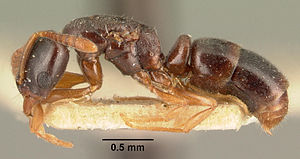Hypoponera punctatissima
| Hypoponera punctatissima | ||||||||||||
|---|---|---|---|---|---|---|---|---|---|---|---|---|

Hypoponera punctatissima |
||||||||||||
| Systematics | ||||||||||||
|
||||||||||||
| Scientific name | ||||||||||||
| Hypoponera punctatissima | ||||||||||||
| ( Roger , 1859) |
Hypoponera punctatissima is an ant from the subfamily of the primeval ants (Ponerinae). It is alsowidespreadas an adventurous species in Central Europe.
features
The elongated body of the workers is 2.5 to 3 millimeters long. The color is dark brown-yellow. Three segments of the 12-part antennas are club-shaped. The Scapi are short and do not extend beyond the head silhouette. The tiny compound eyes consist of no more than five ommatids that are almost fused into one another . The triangular mandibles have four or five larger teeth on the chewing margin, followed by other small teeth. The ergatoid males are always wingless and vary greatly in size. They are similar to the workers, but have 13-articulated antennae and no defensive sting . Because of the strong size dimorphism, they are divided into "major" males and "minor" males. In addition to the winged, gynomorphic females, which are capable of active long-distance spread, there are also ergatomorphic , wingless females. These cannot establish their own colonies and remain in the mother's nest.
distribution and habitat
Hypoponera punctatissima is cosmopolitan and originally comes from the tropics. In Western Europe the species was introduced 1500 years ago. In Central Europe it can be found in places that are warm all year round, such as in compost and waste heaps, where decomposition heat is generated, or in underground heat sources. It also settles in buildings with an intact soil substrate, such as in greenhouses or stables. Since 1950 there have apparently been more and more permanent settlements in natural habitats. Apparently this is favored by global warming .
Way of life
The species is characterized by its hidden way of life. In the hunt for carrion and animal prey (smaller insects and other arthropods), the female workers move mainly in the litter layer or underground. Usually only winged young queens are encountered, who are attracted to light and can sting quite aggressively. These gynomorphic females swarm between late May and early September. They found their colonies independently and semiclaustrally. The colonies become weakly polygynous , whereby the new queens can be ergatomorphic. Peoples that belong together can also spread over several nests (polydomy). A single nest contains a maximum of 200 workers and three queens. There are also a maximum of 20 males (three “major” males and 17 “minor” males). Mating takes place in the nest (intranidal). The "major" males living permanently in the colony lead killing battles to mate the young queens. The "minor" males are excluded from the fighting.
Harmful effect
Because of the zoophage diet and the low population strength, they pose a far less problem in living spaces than the pharaoh ant ( Monomorium pharaonis ).
Systematics
Synonyms
The following synonyms for Hypoponera punctatissima are known from the literature :
- Ponera punctatissima Roger, 1859
- Ponera androgyna Roger, 1859
- Ponera tarda Charsley, 1877
- Ponera punctatissima r. jugata Forel, 1892
- Ponera punctatissima var.exacta Santschi, 1923
swell
Individual evidence
- ^ A b Hypoponera punctatissima (Roger). Manaaki Whenua - Landcare Research, accessed July 6, 2008 .
- ↑ a b c d Bernhard Seifert : The ants of Central and Northern Europe . lutra Verlags- und Vertriebsgesellschaft, Görlitz / Tauer 2007, ISBN 978-3-936412-03-1
- ^ Hypoponera punctatissima (Roger, 1859). www.formicidae.be, accessed July 6, 2008 .
Web links
- Hypoponera punctatissima in Fauna Europaea